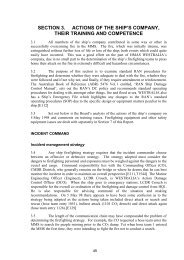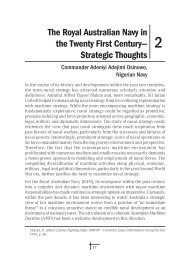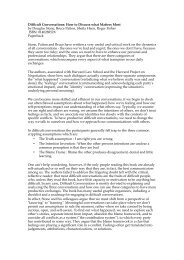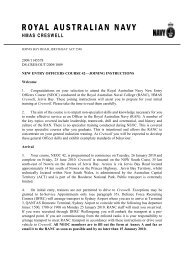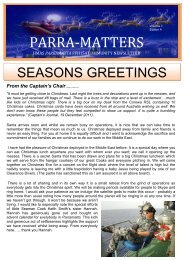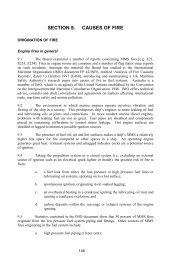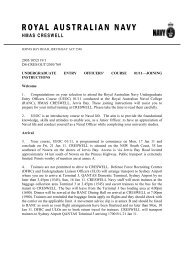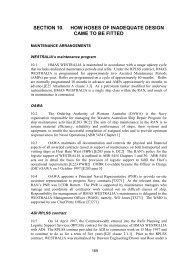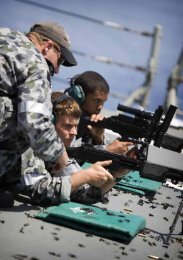30955 DEFENCE Mitchell Essay 02 - Royal Australian Navy
30955 DEFENCE Mitchell Essay 02 - Royal Australian Navy
30955 DEFENCE Mitchell Essay 02 - Royal Australian Navy
Create successful ePaper yourself
Turn your PDF publications into a flip-book with our unique Google optimized e-Paper software.
<strong>Australian</strong> Constabulary Operations<br />
Lieutenant Commander Nick Tate,<br />
<strong>Royal</strong> <strong>Australian</strong> <strong>Navy</strong><br />
Our Mission is to fight and win in the maritime environment as an element<br />
of a joint or combined force, to assist in maintaining Australia’s sovereignty<br />
and to contribute to the security of our region.<br />
RAN Mission Statement1 The Australia Defence Association, in its 20<strong>02</strong> submission to a Senate<br />
Committee, cited that the <strong>Royal</strong> <strong>Australian</strong> <strong>Navy</strong> (RAN) is over-stretched due<br />
to the excessive reliance by the <strong>Australian</strong> Government on its constabulary<br />
role. For example, ‘Three frigates, instead of the usual patrol boats (PB), were<br />
committed to intercepting asylum seekers because of the policy of preventing<br />
landing at Christmas Island which is outside the range of the PB and which<br />
lacks port facilities that would permit their being … stationed there.’ They<br />
also indicated there is almost no ability to undertake other unpredicted<br />
operational requirements such as interception of distant fish poachers without<br />
compromising existing operations. 2<br />
The RAN has reported to Parliament 3 that its level of current operations has<br />
detracted from its ability to train in some warfare disciplines. It further reported<br />
commitments to current operations had placed a high demand on all resources<br />
and that some capabilities needed to be placed in a lower state of readiness to<br />
allow for reconstitution. 4 The operations reported included support to the war<br />
on terrorism, enforcement of United Nations sanctions against Iraq, peace<br />
monitoring on Bougainville, illegal immigration, fisheries and other constabulary<br />
functions. Operations in support of fisheries, illegal immigration and other<br />
constabulary functions can broadly be described as Maritime Law Enforcement<br />
1 <strong>Royal</strong> <strong>Australian</strong> <strong>Navy</strong>, Our Mission: <strong>Navy</strong> 2001-20<strong>02</strong>, Canberra, 2001, p. 1.<br />
45<br />
5<br />
2 Australia Defence Association, 20<strong>02</strong>, Submission on a Certain Maritime Incident to the Select<br />
Committee of the <strong>Australian</strong> Senate appointed to inquire into a certain maritime incident, p. 5.<br />
accessed 29 September 2003 at www.aph.gov.au/senate/committee/maritime_incident_ctte/<br />
submissions/sub03.pdf<br />
3 Department of Defence, Defence Annual Report 2001-<strong>02</strong>, Defence Publishing Service, Canberra,<br />
20<strong>02</strong>, pp. 87-95.<br />
4 Reconstitution is the process to restore capability and preparedness allowing for leave,<br />
maintenance, reconfiguration, training and work-up.
46 PETER MITCHELL ESSAYS 2003<br />
(MLE). Other functions broadly support the RAN’s warfighting role. This author<br />
contends that, with the exception of the PB Force Element Group (FEG), most<br />
of the RAN’s training and operations are in direct support of the warfighting<br />
role. MLE appears to be of lessor priority, except where specifically directed<br />
by Government, and suffers from being applied in an ad hoc manner.<br />
The purpose of this essay is to review whether the RAN is adequately<br />
structured to undertake MLE tasks whilst ensuring its capability for<br />
warfighting role remains effective. This will be achieved by firstly describing<br />
the scope of the MLE task and identifying how it is currently achieved.<br />
Secondly, the RAN’s involvement in MLE will be reviewed including its<br />
interrelationship with the warfighting role. Finally, this essay will discuss<br />
whether RAN structure or capabilities require any change.<br />
Maritime Law Enforcement<br />
To describe MLE and its achievement requires a review of the pertinent<br />
jurisdiction and legislation issues, identifying the range of Government<br />
authorities involved, how it is coordinated, and what the role encompasses.<br />
The contention of most commentators is that Australia has no overriding<br />
jurisdiction covering MLE for maritime areas under its control. 5 Australia’s<br />
Oceans Policy6 attempts to explain the complex web of jurisdictional<br />
arrangements, including the States and the Northern Territory being responsible<br />
for internal waters and the first three nautical miles of territorial sea. 7<br />
Australia is a party to the United Nations Convention on the Law of the Sea,<br />
1982 8 (UNCLOS) and has claimed internal waters, 9 a territorial sea, contiguous<br />
zone 10 and Exclusive Economic Zone (EEZ). 11 It is not the purpose of this essay<br />
5 Woolner, D., ‘<strong>Australian</strong> Coastal Surveillance: Changing Policy Pressures’, Maritime Studies,<br />
119, July/August 2001, pp. 1-9.<br />
6 Environment Australia, Australia’s Oceans Policy, Marine Group, <strong>Australian</strong> Government<br />
Publishing Service, Canberra, 1998, pp. 41-42.<br />
7 United Nations Convention on the Law of the Sea (UNCLOS), Article 2: Territorial Sea. ‘The<br />
sovereignty of a coastal State extends, beyond its land territory and internal waters and, in<br />
the case of an archipelagic State, its archipelagic waters, to an adjacent belt of sea, described<br />
as the territorial sea. UNCLOS, Article 3: Breadth of the territorial sea. Australia claims 12nm<br />
from a baseline set in accordance with Articles 5-16.<br />
8 UNCLOS came into effect on 16 November 1994.<br />
9 UNCLOS, Article 8: Internal Waters – ‘waters on the landward side of the baseline of the<br />
territorial sea form part of the internal waters of the State.’<br />
10 UNCLOS, Article 33: Contiguous Zone – contiguous to the territorial sea, claimed by Australia<br />
out to 24nm from baseline.<br />
11 UNCLOS, Article 55-75: Exclusive Economic Zone – Australia claims an EEZ from 12nm from<br />
baseline to 200nm from the baseline.
AUSTRALIAN CONSTABULARY OPERATIONS<br />
to define all of the issues with respect to each zone. However, simplistically,<br />
Australia is entitled to both legislate over, and enforce jurisdiction, for most<br />
domestic law to the territorial sea. 12 One major exception applies to ships<br />
conducting ‘innocent passage’ 13 through the territorial sea. Jurisdiction<br />
diminishes as vessels get further away from land. In the contiguous zone,<br />
Australia is only entitled to enforce its domestic law with respect either to<br />
preventing or punishing infringements of its customs, fiscal, immigration or<br />
sanitary laws and regulations. 14 In its EEZ, Australia has the right to exploit<br />
living and non-living resources, and the concomitant obligation to protect<br />
and conserve the marine environment, jurisdiction is therefore limited to these<br />
aspects. Australia’s jurisdiction covers an area of 37,000 kilometres of<br />
coastline, with rights and responsibilities over 16 million square kilometres<br />
of offshore maritime area. 15<br />
In order to meet its international obligations 16 Australia has passed various<br />
pieces of domestic legislation. A plethora of <strong>Australian</strong> Government<br />
departments is responsible for Federal level legislation and enforcement. 17<br />
The pertinent domestic legislation that impacts on RAN responsibilities when<br />
dealing with MLE includes: the Customs Act 1901, the Migration Act 1958, the<br />
Fisheries Management Act 1991, the Crimes Act 1914, the Torres Strait Fisheries<br />
Management Act 1984, the Petroleum (Submerged Lands) Act 1967, and the<br />
Environment Protection (Biodiversity Conservation) Act 1999. 18<br />
12 However, sovereignty over the territorial sea is not total. It is exercised subject to UNCLOS<br />
and to other rules of international law.<br />
13 UNCLOS, Article 17: ‘ships of all States … enjoy innocent passage through the territorial sea.’<br />
14 UNCLOS, Article 33(1): ‘In … the contiguous zone, the coastal State may exercise the control<br />
necessary to: (a) prevent infringement of its customs, fiscal, immigration or sanitary laws<br />
and regulations within its territory or territorial sea; (b) punish infringement of the above<br />
laws and regulations committed within its territory or territorial sea.’<br />
15 Environment Australia, Australia’s Oceans Policy, Environment Australia, 1998, p. 7.<br />
16 These obligations include UNCLOS, the International Safety of Life at Sea Convention 1974<br />
(SOLAS), and the International Search and Rescue Convention 1979.<br />
17 The <strong>Australian</strong> Government departments include: the <strong>Australian</strong> Customs Service (border<br />
control), Department of Immigration, Multicultural and Indigenous Affairs (migration),<br />
<strong>Australian</strong> Quarantine and Inspection Service (quarantine), <strong>Australian</strong> Fisheries Management<br />
Authority (living marine resources), <strong>Australian</strong> Maritime Safety Authority (maritime safety<br />
and pollution), Department of Industry, Science, Tourism and Resources (non living marine<br />
resources) and the <strong>Australian</strong> Federal Police (crime).<br />
18 Moore, C., ‘Legal Issues Surrounding an <strong>Australian</strong> Coastguard’, in Journal of the <strong>Australian</strong><br />
Naval Institute, Winter 20<strong>02</strong>, pp. 6-11. This is not an exhaustive list but represents the bulk of<br />
the civil MLE responsibilities of the RAN.<br />
47
48 PETER MITCHELL ESSAYS 2003<br />
The customs and migration legislation was adjusted in 1999 when the Prime<br />
Minister’s Coastal Surveillance Task Force 19 recommended ‘comprehensive<br />
legislative amendments be introduced to further strengthen maritime<br />
investigatory and enforcement powers against both <strong>Australian</strong> and foreign<br />
flag vessels.’ 20 The resulting Border Protection Legislation Amendment Act 1999<br />
gave the <strong>Australian</strong> Defence Force (ADF) a greater range of new powers<br />
without the requirement to obtain a warrant. The legislation attempted to<br />
enshrine in domestic law some principles from the United Nations Convention<br />
on the Law of the Sea (UNCLOS) such as hot pursuit, the contiguous zone,<br />
and powers over ships without nationality on the high seas. 21<br />
The MV Tampa 22 incident of late August 2001 highlighted more operational<br />
and policy problems with the legislation 23 so the Government pushed additional<br />
legislation through Parliament. The resulting Border Protection (Validation and<br />
Enforcement) Act 2001 and Migration (Excision from Migration Zone) Act 2001<br />
adjusted the Migration and Customs Acts and again increased the ADF powers<br />
substantially. 24 In particular, for ships or aircraft boarded for a suspected<br />
breach of either the Customs Act or the Migration Act, the legislation empowers<br />
19 Hancock, N., Border Protection Bill 2001, Bills Digest No.41 2001-<strong>02</strong>, Department of the<br />
Parliamentary Library, p. 1. Because of two undetected landings of illegal entrants on the<br />
eastern coast of Australia in 1999, the Prime Minister established a Coastal Surveillance Task<br />
force. The task force was lead by Mr Max Moore-Wilton, Secretary of the Department of Prime<br />
Minister and Cabinet, with the Chief of the Defence Force, and Secretaries of the Departments<br />
of Defence and Immigration and Multicultural Affairs, Chief Executive Officer <strong>Australian</strong><br />
Customs, and Director General Office of National Assessments.<br />
20 Prime Minister’s Coastal Surveillance Task Force, Report of the Prime Minister’s Coastal<br />
Surveillance Task Force, June 1999, Recommendation 17.<br />
21 Gately, W., & Moore, C., ‘Protecting Australia’s Maritime Borders: The Operational Aspects’,<br />
in Tsamenyi, M., & Rahman, C. (editors), Protecting Australia’s Maritime Borders: The MV Tampa<br />
and Beyond, Wollongong Papers on Maritime Policy No. 13, Centre for Maritime Policy,<br />
University of Wollongong, Wollongong, 20<strong>02</strong>, pp. 37-57.<br />
22 On 26 August 2001, Coastwatch detected a wooden fishing boat in the vicinity of Christmas<br />
Island. The boat broke down and was subsequently assisted by the MV TAMPA. The TAMPA<br />
took onboard 438 unauthorised arrivals but was prevented from landing the passengers at<br />
Christmas Island by the Governments use of the ADF. Source: Hancock, N., Border Protection<br />
Bill 2001, Bills Digest No.41 2001-<strong>02</strong>, Department of the Parliamentary Library.<br />
23 The legislation was written with an intercept, arrest and detain focus, whereas the policy<br />
changed to an intercept, repel or return focus.<br />
24 Gately, W., & Moore, C., ‘Protecting Australia’s Maritime Borders: The Operational Aspects’,<br />
pp. 37-57.
AUSTRALIAN CONSTABULARY OPERATIONS<br />
all ADF personnel as officers under the relevant act. 25 The authorisation is<br />
generally limited to the purposes of boarding, search, seizure, confirm identity<br />
and arrest without warrant, 26 and detention of Suspected Unlawful Non Citizens. 27<br />
Whilst the RAN has no responsibility for developing or maintaining any of<br />
this legislation it has the bulk of the offshore enforcement capability.<br />
Coastwatch has coordinated border protection and other MLE operations since<br />
its formation in 1988 with the RAN supporting these operations since the late<br />
1960s. 28 Coastwatch is a division of the <strong>Australian</strong> Customs Service and is<br />
headed by a RAN Rear Admiral who reports to the Chief Executive Officer of<br />
Customs. Coastwatch usually acts as a coordinator of MLE operations for<br />
<strong>Australian</strong> Government departments or agencies, known as clients. Coastwatch<br />
does not own any of its own surveillance or interdiction assets and is also not<br />
involved in policy or legislation development. Coastwatch utilises civilian<br />
aircraft contractors, RAN ships (mainly PB), <strong>Royal</strong> <strong>Australian</strong> Air Force (RAAF)<br />
P3-C Orion surveillance aircraft and Customs National Marine Unit (CNMU)<br />
PB. 29 Intelligence support is provided by the clients as well as Defence. The<br />
Joint Committee of Public Accounts and Audit (JCPAA), in its review of<br />
Coastwatch, found that the Government’s recent priority on illegal immigration<br />
had diminished Coastwatch’s effectiveness in responding to fishing issues. 30<br />
However, all the client agencies were still satisfied with the level of support<br />
they received from Coastwatch.<br />
According to Australia’s Oceans Policy, the ADF has an important role to ‘protect<br />
Australia’s national interests and sovereign rights.’ 31 There is a tension<br />
between wider Government policy and Defence 2000, the Defence White Paper.<br />
In Australia’s Oceans Policy, the RAN has to ‘maintain a visible presence on<br />
and over the sea’ with an expectation to ‘contribute fully to fisheries law<br />
enforcement activities’ including within Australia’s offshore territories.<br />
Defence 2000 acknowledges the requirement to play an increasing and major<br />
25 Border Protection (Validation and Enforcement) Act, Customs Act, and Migration Act.<br />
26 Migration Act section 245F, Customs Act section 185.<br />
27 Migration Act section 189.<br />
28 The RAN provides a historical minimum of 1800 patrol boat days per year in support of this<br />
governmental approach to border protection. Source: Defence Annual Reports 1997–2001.<br />
29 Parliament of the Commonwealth of Australia. Joint Committee of Public Accounts and Audit,<br />
Report 384: Review of Coastwatch, Canberra, 2001, p. 2.<br />
30 Parliament of the Commonwealth of Australia. Joint Committee of Public Accounts and Audit,<br />
Report 384: Review of Coastwatch, pp. 101-104.<br />
31 Environment Australia, Australia’s Oceans Policy – Specific Sectoral Measures, Marine Group,<br />
<strong>Australian</strong> Government Publishing Service, Canberra, 1998, p. 5.<br />
49
50 PETER MITCHELL ESSAYS 2003<br />
part in these roles, however, will ‘ … not allow these roles – important as they<br />
are – to detract from the ADF’s core function of defending Australia from armed<br />
attack.’ 32 Defence 2000 also highlights that the ADF is not the most costeffective<br />
option at times and indicates that the <strong>Australian</strong> Government would<br />
prefer civilian responses to these issues.<br />
RAN Involvement<br />
Having described how the RAN is integral to Australia’s current approach to<br />
MLE, it is worth exploring what that involvement actually consists of. The<br />
Chief of <strong>Navy</strong> (CN) recently identified MLE tasks as all being high profile and<br />
demanding requirements. 33 The RAN is heavily involved with the primary<br />
assets being the PB FEG with the requirements for PB surveillance and<br />
response capabilities expected to increase over the coming decade. 34<br />
The main problem with the current approach is the use of more expensive,<br />
and sometimes inappropriate, platforms for the task. Whilst 80 per cent of PB<br />
effort is directed at MLE, other FEGs have increasingly become involved in<br />
border protection tasks in particular. This additional involvement has been<br />
necessary because of the Government’s focus on people smuggling. Since<br />
November 2001, the successful intervention of Operation RELEX, the multidepartmental<br />
response to people smuggling, with one exception, 35 there have<br />
been no known unauthorised boat arrivals since 16 December 2001.<br />
Operation RELEX’s aim was ‘to prevent, in the first instance, the incursion of<br />
unauthorised vessels into <strong>Australian</strong> waters such that, ultimately, people<br />
smugglers and asylum seekers would be deterred from attempting to use<br />
Australia as a destination.’ 36 The lead Government agency for RELEX is the<br />
ADF in lieu of Coastwatch. It consists of the use of RAN major fleet units in<br />
addition to the usual Coastwatch regime. As a result of this increased tempo,<br />
32 Commonwealth of Australia, Defence 2000 – Our Future Defence Force, Defence Publishing<br />
Service, Canberra, 2000, p. 13.<br />
33 Ritchie, C., ‘The RAN today and tomorrow’, presentation to the United Service Institution of<br />
the <strong>Australian</strong> Capital Territory Inc, 6 August 2003, at www.defence.gov.au/rusi/state/<br />
act%20lectures%20ritchie.htm. Tasks such as the ongoing border protection activities drug<br />
interdiction and fisheries patrols.<br />
34 Ritchie, C., ‘The RAN today and tomorrow’.<br />
35 As at 15 October 2003. The one exception being a vessel that arrived of Port Hedland 1 July 2003<br />
with 54 passengers, including 28 adult men, 17 adult women and 9 children believed to be<br />
from Vietnam. The vessel does not conform to the Operation RELEX profile.<br />
36 Select Committee on a Certain Maritime Incident report, Chapter 2, Operation Relex, at<br />
www.aph.gov.au/senate/committee/maritime_incident_ctte, p. 13.
AUSTRALIAN CONSTABULARY OPERATIONS<br />
in financial year 2001-<strong>02</strong> the RAN provided 2103 PB days, an additional 303<br />
days over the usual rate of effort for MLE. The other FEG’s provided additional<br />
ships for MLE tasks. HMAS Tobruk was used for 185 days of MLE, and the<br />
hydrographic force provided 451 days. 37 The major surface combatant FEG<br />
also provided an estimated 365 days although their contribution was not<br />
separately reported. 38<br />
The discussion on the appropriateness of using the RAN for MLE centres on<br />
two aspects, cost effectiveness and the appropriateness of a military force<br />
undertaking what some believe to be an essentially civilian role. Cost<br />
effectiveness was a significant issue explored by the JCPAA. It found that<br />
RAN provided vessels were more expensive in terms of capital and running<br />
costs. 39 The Labour party identified that civil operations make significant<br />
savings in personnel costs through not having to pay military superannuation<br />
and service allowances or provide Defence Housing. 40 The main difference<br />
between RAN conditions of service and the Customs Workplace agreement is<br />
really the housing component, as CNMU personnel are paid higher allowances<br />
whilst at sea. 41 CNMU personnel can reside almost anywhere in the country<br />
as long as they have access to a major airport so they can fly to join their PB<br />
as required. CNMU also has a multi-crewing concept ensuring greater sea<br />
days availability per platform, therefore reducing the capital cost per sea day.<br />
If one accepts that the RAN cost of providing PB is greater than that of the<br />
CNMU, then the cost of using a frigate for border protection operations is<br />
even more uneconomical. One could argue that a frigate is not an efficient<br />
vehicle for MLE. The reason they are used is due to large distances and lack of<br />
port facilities that make the use of a PB difficult.<br />
One could also argue that the CNMU is generally using the same pool of<br />
people targeted by the RAN for employment. However, a counter argument is<br />
that CNMU provides a civil employment opportunity for those interested in<br />
37 Department of Defence, Defence Annual Report 2001-<strong>02</strong>, Defence Publishing Service, Canberra,<br />
20<strong>02</strong>, pp. 87-95.<br />
38 The estimate is based on one Surface Combatant being based at Christmas Island for the full year.<br />
39 Parliament of the Commonwealth of Australia. Joint Committee of Public Accounts and Audit,<br />
Report 384: Review of Coastwatch, p. 131.<br />
40 Thomas, T., ‘Coast Guard v Coastwatch: Who’s right?’, in <strong>Australian</strong> Defence Business Review,<br />
Vol. 20 No. 15, 28 September 2001, pp. 10-13.<br />
41 <strong>Australian</strong> Customs Service, Certified Agreement 20<strong>02</strong>-2004, <strong>Australian</strong> Customs Service,<br />
Canberra, 20<strong>02</strong>.<br />
51
52 PETER MITCHELL ESSAYS 2003<br />
developing their seagoing career without having to resort to military service,<br />
with its potential for being sent to conflict. Thus, the Government has a greater<br />
range of people applying than would only for military service.<br />
There have been many calls for the creation of a coastguard to take the roles the<br />
RAN currently undertakes. CN stated that MLE tasks ‘are legitimate roles for<br />
navies.’ He cautioned against any suggestions of attempting to save money by<br />
either structuring the RAN as more of a coastguard or establishing a separate<br />
coastguard. 42 His statements are supported by <strong>Australian</strong> Maritime Doctrine<br />
which describes the modern span of operations to cover benign to coercive<br />
roles including military; constabulary; and diplomatic as shown in Figure 1. 43<br />
Services Protected<br />
Evacuation<br />
Coercion<br />
COERCIVE<br />
Defence Force Assistance<br />
to the Civil Community<br />
Search and Rescue<br />
Defence Force Assisance to<br />
Allied and Friendly Navies<br />
Services Assisted<br />
Evacuation<br />
Disaster Relief<br />
Presence<br />
DIPLOMATIC<br />
BENIGN<br />
Combat Operations<br />
At Sea<br />
•Intelligence Collection and Surveillance<br />
•Cover<br />
•Against Shipping<br />
• Maritime Strike<br />
• Containment by Distraction<br />
• Barrier Operations<br />
•Layered Defence<br />
•Advance Force Operations<br />
•NCS<br />
Figure 1: <strong>Australian</strong> Span of Maritime Operations 44<br />
42 Ritchie, C., ‘The RAN today and tomorrow’.<br />
Degree of Force<br />
Employed<br />
MILITARY<br />
Environmental and<br />
Resource Management<br />
Peace Buillding<br />
Environmental and<br />
Resource Protection<br />
Quarantine Operations<br />
Prevention of<br />
Illegal Immigration<br />
CONSTABULARY<br />
Combat Operations<br />
From the Sea<br />
• Maritime Mobility<br />
• Land Strike<br />
• Amphibious Operations<br />
• Support to Operations on Land<br />
Peace Keeping<br />
Defence Aid<br />
to the Civil Power<br />
Drug Interdiction<br />
Anti-Piracy Operations<br />
Peace Enforcement<br />
43 <strong>Royal</strong> <strong>Australian</strong> <strong>Navy</strong>, <strong>Australian</strong> Maritime Doctrine (RAN Doctrine 1), Defence Publishing<br />
Service, 2000, p. 57.<br />
44 <strong>Royal</strong> <strong>Australian</strong> <strong>Navy</strong>, <strong>Australian</strong> Maritime Doctrine (RAN Doctrine 1), p. 57. This concept has<br />
been derived from the ideas advanced by Ken Booth in Navies and Foreign Policy and developed<br />
by Eric Grove in The Future of Sea Power.
AUSTRALIAN CONSTABULARY OPERATIONS<br />
The premise offered by CN is that ‘naval forces structured and trained for the<br />
traditional military warfighting roles can easily undertake the less demanding<br />
diplomatic and constabulary ones, but the reverse is not true.’ 45 This is used<br />
as the argument for the RAN to be primarily structured for war. In the author’s<br />
opinion, this is often used, with the exception of the PB force, as an excuse for<br />
not procuring extra capabilities such as those required for Southern Ocean<br />
patrols. Dupont (2003) seems to have a similar view. He believes that the<br />
ADF needs to rethink its force structure to take into account ‘a broader<br />
spectrum of threats including non-traditional challenges to security which<br />
have often been viewed by the military as something of a side-show, a<br />
distraction from their core business of preparing for and conducting ‘highend’<br />
war-fighting.’ 46 Dupont believes Government needs to recognise that<br />
modern defence forces must win the peace as well as the war. He focuses, to<br />
some extent, on the RAN being involved in MLE, although he places more<br />
emphasis on criminal activities. 47<br />
The focus of the civil surveillance program over recent history has been to<br />
the north of Australia and current PB have been suitable for the task. The<br />
focus of attention has now broadened with a number of fisheries operations<br />
being centred on the Southern Ocean. The ADF has reported that distant ocean<br />
operations in difficult seas will require vessels much larger than a PB. 48 Since<br />
the only RAN ships available to undertake these types of operations are the<br />
major surface combatants, they were initially used. However, this was<br />
uneconomical and so a commercial vessel, the MV Southern Supporter, was<br />
chartered to undertake the task. 49<br />
On two occasions this vessel has been unable to make an arrest in EEZ due to<br />
a lack of appropriate equipment and training. Whilst the RAN has both the<br />
equipment and training to undertake this type of hazardous task, and despite<br />
agreeing that having capacity to operate in the Southern Ocean or elsewhere<br />
at the edge of Australia’s EEZ ‘is of national concern,’ Defence has indicated<br />
45 Ritchie, C., ‘The RAN today and tomorrow’.<br />
46 Dupont, A., Transformation or Stagnation? Rethinking Australia’s Defence. Presentation to the<br />
United Service Institution of the <strong>Australian</strong> Capital Territory Inc, 25 February 2003, at<br />
www.defence.gov.au/rusi/state/act%20lectures%20dupont.htm.<br />
47 Such as narcotics smuggling and terrorism.<br />
48 Department of Defence, submission to the Joint Committee on Public Accounts and Audit,<br />
Inquiry into Coastwatch, vol. 2, p. S276, in Woolner, D., ‘<strong>Australian</strong> Coastal Surveillance:<br />
Changing Policy Pressures’, Maritime Studies, 119, July/August 2001, pp. 1-9.<br />
49 Woolner, D., ‘<strong>Australian</strong> Coastal Surveillance: Changing Policy Pressures’, Maritime Studies,<br />
119, July/August 2001, p. 7.<br />
53
54 PETER MITCHELL ESSAYS 2003<br />
that ‘there is no strategic justification for developing this capability.’ 50 However,<br />
the JCPAA recommended that Defence should investigate the acquisition of a<br />
suitably armed patrol vessel for the Southern Ocean and other remote areas. 51<br />
The training overhead to ensure safe operation of a ship fitted weapon, and<br />
the particular difficulties of operating a boarding party in the Southern Ocean<br />
are significant. One could argue that the RAN is the only suitable organisation<br />
in Australia that could competently operate an armed vessel of this type.<br />
Having identified the ad hoc and uncoordinated arrangements of MLE tasks,<br />
some review of possible solutions is required. Moore (20<strong>02</strong>) discussed the<br />
implications of the Labour Coastguard bill and proposed some alternative<br />
structures for enhancing MLE. 52 These included enhancing Coastwatch,<br />
moving the PB FEG and CNMU to Coastwatch, or absorbing the role into <strong>Navy</strong><br />
by creating a coastguard as a new arm. McLennan (20<strong>02</strong>) identified that a<br />
navy coastguard would be the answer, with specialised personnel, in the same<br />
vein as, and subsuming, the current hydrographic branch. He identified that<br />
it could be a component of Headquarters <strong>Australian</strong> Theatre or placed within<br />
Maritime Command. 53 The JCPAA concluded that the current Coastwatch<br />
model is in effect an ‘outsourced coastguard’ 54 and that Coastwatch was the<br />
most efficient and effective model of the alternatives proposed.<br />
CN appears to support this view, believing the RAN should concentrate most<br />
of its effort on the warfighting role. Whilst accepting that a coastguard may<br />
not be the most appropriate solution, this author finds it difficult to<br />
comprehend the basis of CN’s view. It appears to accept the ad-hoc<br />
arrangements currently in place for MLE or other Military Operations Other<br />
Than War. A point well made by Dupont is that ‘ad hoc responses lead to<br />
sub-optimal performance and operational over-stretch, endangering lives<br />
and jeopardising mission objectives.’ 55<br />
50 Department of Defence, submission to the Joint Committee on Public Accounts and Audit,<br />
Inquiry into Coastwatch, vol. 2, p. S280, in Woolner, D., ‘<strong>Australian</strong> Coastal Surveillance:<br />
Changing Policy Pressures’, p. 7.<br />
51 Parliament of the Commonwealth of Australia. Joint Committee of Public Accounts and Audit,<br />
Report 384: Review of Coastwatch., p. xxi.<br />
52 Moore, C., ‘Legal Issues Surrounding an <strong>Australian</strong> Coastguard’, in Journal of the <strong>Australian</strong><br />
Naval Institute, Winter 20<strong>02</strong>, pp. 6-11.<br />
53 McLennan, B., ‘Maritime Border Protection and the <strong>Royal</strong> <strong>Australian</strong> <strong>Navy</strong>: Threat or<br />
Opportunity’, in Protecting Australia’s Maritime Borders: The MV TAMPA and beyond, Wollongong<br />
Papers on Maritime Policy, No 13, pp. 117-143.<br />
54 Parliament of the Commonwealth of Australia. Joint Committee of Public Accounts and Audit,<br />
Report 384: Review of Coastwatch, pp. 148-149.<br />
55 Dupont, A., Transformation or Stagnation? Rethinking Australia’s Defence.
AUSTRALIAN CONSTABULARY OPERATIONS<br />
Recent history has shown that the PB FEG will not be the only FEG involved<br />
in MLE and that a wide range of skills used in MLE are readily transferable to<br />
combat roles. This is supported by Hill (1988) who identifies how, as a medium<br />
power navy, the experience and forces required for each level of conflict build<br />
on each other. In normal conditions, navies should be focussed on deterrence<br />
and application of international law. 56 The deterrence function is only achieved<br />
where forces appear capable and ready to undertake higher levels of conflict<br />
if required. This is displayed by a good materiel state, training, and sufficient<br />
communications and intelligence. These are all displayed by undertaking MLE,<br />
which requires appropriate surveillance, and an inherent ability to inform,<br />
warn, board, inspect and if required, detain. 57 Whilst naval diplomacy provides<br />
some presence, undertaking MLE provides a much more solid opportunity for<br />
displaying competence and resolve for deterrence.<br />
Hill describes the second level of conflict as ‘Low Intensity Operations.’ 58 These<br />
operations tend to be political and, more often, economic displays of a nation’s<br />
power and are limited in scope by international ‘principles of self-defence –<br />
necessity and proportionality.’ 59 These principles provide a valuable skillset to<br />
navies, as they require the ability to obtain and process information or<br />
intelligence for both short and long term goals backed up by excellent<br />
communications and planning. Forces must also command ‘a wide spectrum of<br />
violence, from finely discriminating to lethal.’ 60 Government controls its forces<br />
for operations partly through Rules of Engagement and Orders for Opening<br />
Fire. Increased exposure to these controls increases understanding and ensures<br />
a greater ability to both prepare and conduct operations. Hill links these lower<br />
level conflicts to higher level operations and general war, with similar skill sets<br />
required by naval forces, only varying in levels of application. 61<br />
Modern warfare calls for proportionality, and navies cannot afford to be seen<br />
as blunt instruments of mass destruction. Therefore, MLE provides a useful<br />
skill set, but are also an important building block towards higher-level warfare<br />
56 Hill, J., ‘Maritime Strategy for Medium Powers’, Journal of the <strong>Australian</strong> Naval Institute, Volume 14,<br />
May 1988, No. 2, pp. 37-45.<br />
57 Hill, J., ‘Maritime Strategy for Medium Powers’, p. 39.<br />
58 Hill, J., ‘Maritime Strategy for Medium Powers’, p. 39. Hill defines low intensity operations as<br />
those that never merit the title of war, are limited in aim, scope and area, and are subject to<br />
the international law of self-defence.<br />
59 Hill, J., ‘Maritime Strategy for Medium Powers’, p. 39.<br />
60 Hill, J., ‘Maritime Strategy for Medium Powers’, p. 40.<br />
61 Hill, J., ‘Maritime Strategy for Medium Powers’, p. 40.<br />
55
56 PETER MITCHELL ESSAYS 2003<br />
skills. They assist the RAN’s deterrence function in support of maintaining<br />
Australia’s sovereignty and contributing to the security of the region. If one<br />
can accept this argument, then clearly the RAN should ensure it is heavily<br />
immersed in the role. The question is then to what extent should this occur<br />
and do they interfere with higher-level warfare skills. Clearly, Defence has<br />
reported that they do, 62 however this is more because of RELEX and the<br />
requirement to conduct long range EEZ operations in such areas as the<br />
Southern Ocean.<br />
Accepting that the RAN must continue to be heavily involved in MLE but that<br />
ad hoc arrangements are inefficient, then some capability or structural change<br />
is appropriate. Two main problems identified in this essay are the inappropriate<br />
use of other FEGs in MLE tasks, and the inefficient use of PB crews. The use<br />
of frigates for MLE, as a primary focus, has already been described as inefficient<br />
and uneconomical. In the author’s opinion, the solution would have been met<br />
had the RAN invested in the Offshore Patrol Vessel which was to be capable<br />
of providing a greater level of activity than the PB. However, politics and<br />
economics will preclude that from occurring. Therefore, as indicated in the JCPAA<br />
report, the RAN should invest in at least one armed patrol vessel that is capable<br />
of operating in the Southern Ocean and the far reaches of Australia’s EEZ. A<br />
possible solution for improving the availability of PB would be to widen the<br />
current multi-crewing regime from the Hydrographic FEG to encompass the<br />
PB FEG. This, combined with crew changes away from homeports, could also<br />
reduce inefficiencies.<br />
Conclusion<br />
Operations in support of fisheries, illegal immigration and other constabulary<br />
functions can broadly be described as MLE. Other functions broadly support<br />
the RAN’s warfighting role. This author contends that, with the exception of<br />
the PB FEG, most of the RAN’s training and operations are in direct support<br />
of the warfighting role.<br />
The purpose of this essay was to review whether the RAN is adequately<br />
structured to undertake MLE tasks whilst ensuring its capability for<br />
warfighting role is remains effective.<br />
The scope of the MLE task was explained using Australia’s Oceans Policy, which<br />
provides an insight into <strong>Australian</strong> policy with respect to its management<br />
and conservation of Australia’s oceans and marine life. Coastwatch coordinates<br />
MLE operations on behalf of its clients supported by the ADF and Customs.<br />
62 Department of Defence, Defence Annual Report 2001-<strong>02</strong>, pp. 87-95.
AUSTRALIAN CONSTABULARY OPERATIONS<br />
This essay discussed whether MLE tasks could be sustained in conjunction<br />
with the warfighting role. The RAN is heavily involved with the primary assets<br />
used by the RAN being the PB FEG. Other FEG’s provided additional ships for<br />
MLE tasks. However, RAN provided vessels are more expensive in terms of<br />
capital and running costs. Whilst MLE tasks are legitimate roles for navies<br />
and do contribute to essential warfighting skillsets the RAN must maintain<br />
the primacy of its warfighting focus.<br />
The ADF has reported that distant ocean operations in difficult seas will require<br />
vessels much larger than a PB. Therefore, the recommendations for appropriate<br />
revisions to structure and capability of the RAN are to reduce the use of major<br />
fleet units in these tasks and that a larger armed patrol vessel be procured to<br />
undertake EEZ patrol tasks. Also, that the RAN incorporates multi crewing<br />
for this role, thus freeing up the major fleet units for their warfighting role.<br />
Bibliography<br />
<strong>Australian</strong> Customs Service, Certified Agreement 20<strong>02</strong>-2004, <strong>Australian</strong><br />
Customs Service, Canberra, 20<strong>02</strong>.<br />
Australia Defence Association, Submission on a Certain Maritime Incident to the<br />
Select Committee of the <strong>Australian</strong> Senate appointed to inquire into a certain<br />
maritime incident, 20<strong>02</strong>, p. 5. accessed 29 September 2003 at<br />
www.aph.gov.au/senate/committee/maritime_incident_ctte/submissions/<br />
sub03.pdf.<br />
Commonwealth of Australia, Defence 2000 – Our Future Defence Force, Defence<br />
Publishing Service, Canberra, 2000.<br />
Department of Defence, Defence Annual Report 2001-<strong>02</strong>, Defence Publishing<br />
Service, Canberra, 20<strong>02</strong>.<br />
Dupont, A., Transformation or Stagnation? Rethinking Australia’s Defence,<br />
presentation to the United Service Institution of the <strong>Australian</strong> Capital<br />
Territory Inc, 25 February 2003, at www.defence.gov.au/rusi/state/<br />
act%20lectures%20dupont.htm.<br />
Environment Australia, Australia’s Oceans Policy, Marine Group, <strong>Australian</strong><br />
Government Publishing Service, Canberra, 1998.<br />
Environment Australia, Australia’s Oceans Policy – Specific Sectoral Measures,<br />
Marine Group, <strong>Australian</strong> Government Publishing Service, Canberra, 1998.<br />
57
58 PETER MITCHELL ESSAYS 2003<br />
Gately, W. & Moore, C., ‘Protecting Australia’s Maritime Borders: The Operational<br />
Aspects’, in Tsamenyi, M. & Rahman, C. (editors), Protecting Australia’s<br />
Maritime Borders: The MV Tampa and Beyond, Wollongong Papers on Maritime<br />
Policy No. 13, Centre for Maritime Policy, University of Wollongong,<br />
Wollongong, 20<strong>02</strong>, pp. 37-57.<br />
Hancock, N., ‘Border Protection Bill 2001’, Bills Digest No.41 2001-<strong>02</strong>,<br />
Department of the Parliamentary Library.<br />
Hill, J., ‘Maritime Strategy for Medium Powers’, Journal of the <strong>Australian</strong> Naval<br />
Institute, Volume 14, May 1988, No. 2, pp. 37-45.<br />
Joint Committee of Public Accounts and Audit, Report 384: Review of<br />
Coastwatch, Parliament of the Commonwealth of Australia, Canberra, 2001.<br />
McLennan, B., ‘Maritime Border Protection and the <strong>Royal</strong> <strong>Australian</strong> <strong>Navy</strong>: Threat<br />
or Opportunity’, in Protecting Australia’s Maritime Borders: The MV TAMPA<br />
and beyond, Wollongong Papers on Maritime Policy, No 13, 20<strong>02</strong>, pp. 117-43.<br />
Moore, C., ‘Legal Issues Surrounding an <strong>Australian</strong> Coastguard’, Journal of<br />
the <strong>Australian</strong> Naval Institute, Winter 20<strong>02</strong>, pp. 6-11.<br />
Prime Minister’s Coastal Surveillance Task Force, Report of the Prime<br />
Minister’s Coastal Surveillance Task Force, June 1999.<br />
Ritchie, C., The RAN today and tomorrow, presentation to the United Service<br />
Institution of the <strong>Australian</strong> Capital Territory Inc, 6 August 2003, at<br />
www.defence.gov.au/rusi/state/act%20lectures%20ritchie.htm.<br />
<strong>Royal</strong> <strong>Australian</strong> <strong>Navy</strong>, <strong>Australian</strong> Maritime Doctrine (RAN Doctrine 1), Defence<br />
Publishing Service, Canberra, 2000.<br />
<strong>Royal</strong> <strong>Australian</strong> <strong>Navy</strong>, Our Mission: <strong>Navy</strong> 2001-20<strong>02</strong>, Defence Publishing<br />
Service, Canberra, 2001.<br />
Select Committee on a Certain Maritime Incident report, Chapter 2, Operation<br />
Relex, at www.aph.gov.au/senate/committee/maritime_incident_ctte.<br />
Thomas, T., ‘Coast Guard v Coastwatch: Who’s right?’ <strong>Australian</strong> Defence<br />
Business Review, Vol 20 No. 15, 28 September 2001, pp. 10-13.<br />
Woolner, D., ‘<strong>Australian</strong> Coastal Surveillance: Changing Policy Pressures’,<br />
Maritime Studies, 119, July/August 2001.



